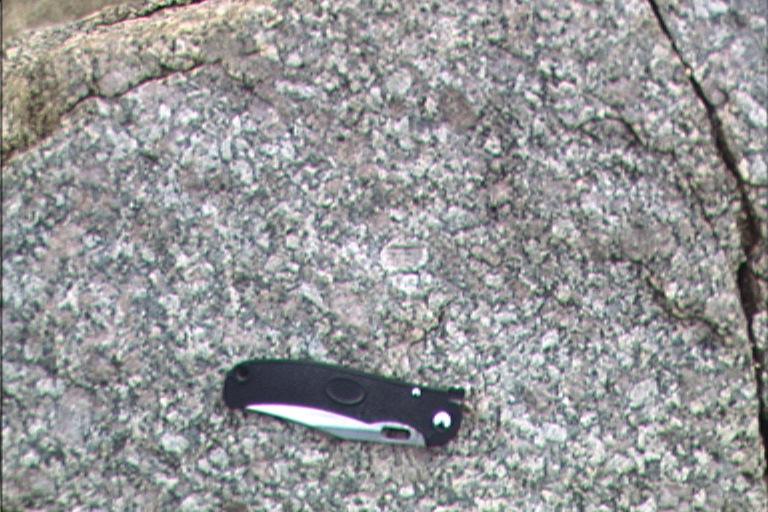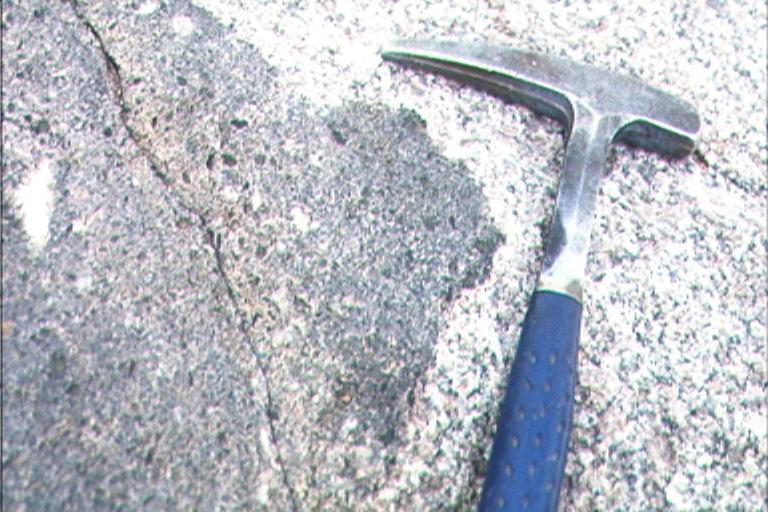
GEOLOGY AND GEOCHEMISTRY OF REDROCK ANORTHOSITE AND GRANITE, NORTHERN BURRO MOUNTAINS, GRANT COUNTY, NEW MEXICO
Virginia McLemore, New Mexico Bureau of Mines and Mineral Resources, February, 2001, updated August 2011
A complex Proterozoic terrain in the northern Burro Mountains
consists of metamorphic rocks (Bullard Peak and Ash Creek Series,
1550-1570 Ma, U/Pb) that are intruded by granitic and mafic rocks.
The granitic rocks include 1) Burro Mountain granite (oldest,
~1445 Ma, U/Pb), 2) gneissic granite/granodiorite (~1380 Ma, K/Ar),
3) Jack Creek rapakivi granite (1220.9±3.5, 1198±4.7
Ma, 40Ar/39Ar), 4) Redrock granite (1210±5, 1204.8±12
Ma, 40Ar/39Ar; 1328±58 Ma Sm/Nd isochron), 5) fine-grained
alkali-feldspar and biotite granite dikes, 6) rhyodacite/dacite
porphyry dikes, and 7) pegmatite dikes (youngest).

Rapakivi texture in Jack Creek rapakivi granite. Rapakivi is
Finish for rotten or crumbly rock and describes the tendency of
the rapakivi granite to easily weather, found throughout the eastern
portion of the game refuge in the northern Burro Mountains. The
rapakivi texture refers to the mantling of K-feldspar phenocrysts
(pink) by plagioclase (white). Most rapakivi granites are middle
to early Proterozoic, although rapakivi textures have been described
from some Phanerozoic and Archean granites. The petrogenesis of
rapakivi granites is controversial and questions remain as to
the source of the rapakivi magma, the genetic relationships between
the granite and penecontemporaneous mafic rocks, the origin of
the rapakivi texture, and the tectonic setting of these rocks.

Photo showing comingling textures along the edges of a minette
pillow in Jack Creek rapakivi granite in Jack Creek, northern
Burro Mountains. K-rich minette as isolated enclaves, swarms of
enclaves, and synplutonic dikes range in size from a few centimeters
to several meters in diameter. The minette is dark gray, fine
to medium grained, and porphyritic with dark mica and, presumably,
pyroxene phenocrysts that have been altered into fine-grained
amphibole; the main constituents in the groundmass are K-feldspar,
dark mica, and amphibole . The enclaves are distinctly finer grained
then the enclosing granite. The crenulate to cuspate margins of
the synplutonic dikes and many of the enclaves show evidence for
intensive mingling with the rapakivi granite host; quartz and
K-feldspar megacrysts have been mechanically incorporated into
the minette and the quartz xenocrysts are locally mantled by biotite
or hornblende. Adjacent to the minette, feldspars within the rapakivi
granite are locally surrounded by biotite and amphibole from the
minette. Other minette pillows have sharp to diffuse contacts
with the host granite. Locally, coarse-grained pegmatitic phases
of the granite form a halo surrounding the minette pillows.

This study began in 1987, when a preliminary investigation of the Proterozoic rocks was undertaken in order to assess their economic potential (McLemore and McKee, 1988). This early investigation also indicated that previous mapping by Hewitt (1959) and Hedlund (1980a, b) did not adequately differentiate the diverse Proterozoic rocks. Subsequent mapping by Finnell (1987) grouped the Proterozoic rocks together as one unit. Additional studies by the authors continued in 1988, 1996, and 1998-2000 and are ongoing (McLemore et al., 1999b; Kosunen et al., 1999; Rämö et al., 1999). Current studies by the authors include detailed mapping and sampling of the Proterozoic rocks in order to explain the petrogenesis of the anorthosites and spatially related granites and minettes, and to assess their economic potential. Approximately 77 km2 are being mapped at a scale of 1:12,000 and transferred to a map scale of 1:24,000 using standard U.S. Geological Survey (USGS) 7½-minute topographic quadrangle maps (Redrock, Brushy Mountain, Mangas Springs, Bullard Peak).
TABLE 1. Age relationships of the Proterozoic and younger
rocks in the northern Burro Mountains.
Units
Volcanic-epithermal veins
Tertiary rhyolite and quartz monzonite dikes and plugs
Tertiary-Cretaceous andesite sills and dikes
Cretaceous Beartooth Quartzite
Proterozoic rocks
Diabase/gabbro/diorite dikes
Pegmatites dikes
Serpentinite veins
Fine-grained biotite and K-feldspar granite dikes (1206±15
Ma, 40Ar/39Ar)
Rhyodacite-dacite porphyry dikes
Redrock granite (1328±58 Ma Sm/Nd isochron)
Miarolitic biotite granite
K-feldspar granite
Hornblende granite (1210±5, 1204.8±12
Ma, 40Ar/39Ar)
Biotite-hornblende granite
Jack Creek rapakivi granite (1220.9±3.5, 1198.0±4.7
Ma, 40Ar/39Ar)
Minette (1420.5±4.5 Ma, 40Ar/39Ar; 1135±71
Ma Sm/Nd isochron)
Anorthosite/leucogabbro (1216.9±5.3, 1228.5±4.5
Ma, 40Ar/39Ar; 1326±830 Ma Sm/Nd isochron)
Diabase/diorite/gabbro (1500-1535 Ma, U/Pb, Stacey and Hedlund,
1983; but the dike intruded the 1445 Ma Burro Mountains granite)
Gneissic granite/granodiorite (1380±45 Ma, K/Ar,
Hedlund, 1980b) (Ygd of Hedlund)
Burro Mountain granite (1169±11 Ma, 40Ar/39Ar; correlated
to 1445±10 Ma U/Pb by Hedlund, 1980b) (Yg of Hedlund, 1980a,
b)
Bullard Peak and Ash Creek Metamorphic rocks (1550-1570
Ma, U/Pb, Stacey and Hedlund, 1983)
Quartz-feldspathic gneiss (1202.3±2.4 Ma, 40Ar/39Ar)
(granulite of Hedlund, 1980a)
| Sample | Published ages (Ma) (Hedlund, 1980a, Stacey and Hedlund, 1983) | 40Ar/39Ar (Ma) (mineral dated) | Nd/Sm isochron Ma | Rb/Sr isochron Ma |
|---|---|---|---|---|
| Gabbro/diabase/diorite dikes | ||||
| NM118-98 | *~1000 (horndblende) | |||
| Rhyodacite-dacite porphyry dikes | ||||
| NM1G | *~1200 (hornblende) | |||
| Fine-grained biotite granite dike (related to Redrock Granite) | ||||
| NM84-98 | 1206±15 (biotite) | |||
| Redrock Granite | 1328±58 (n=4) | ~1250 | ||
| NM19-98 | *~1200 (hornblende) | |||
| NM93-98 | 1210±5 (hornblende) | |||
| 1204.8±12 (biotite) | ||||
| NM279-99 | *~1200 (biotite) | |||
| Jack Creek rapakivi granite | 1135±71 (n=5) | ~1300 | ||
| Red17 | 1198.0±4.7 (biotite) | |||
| NM17-96 | 1220.9±3.5 (biotite) | |||
| NM217-99 | 1208.6±1.9 (biotite) | |||
| NM230-99 | 1384±3 (biotite) | |||
| NM234-99 | 1335.4±0.7 (biotite) | |||
| Anorthosite | 1326±830 (n=4) | |||
| Red7A | 1228.5±4.5 (hornblende) | |||
| Red7B | 1216.9±5.3 (hornblende) | |||
| Diabase dike | 1500-1535 (U-Pb on zircon) | |||
| Metamorphic rocks | 1550-1570 (U-Pb on zircon) | |||
| NM101-98 | 1202.3±2.4 (muscovite) | ~1340 |
REFERENCES
- McLemore, V. T., 1988, Geology and geochemistry of the Redrock anorthosites, Burro Mountains, southwestern New Mexico; Preliminary Observations; abstr. and poster presented at the Penrose Conference on Origin of massif anorthosites, Wyoming, Aug. 14-19, 1988. (unpublished).
- McLemore, V. T., and McKee, C., 1988, A preliminary geochemical study of the Redrock anorthosite and granite, Burro Mountains, southwestern New Mexico: New Mexico Geological Society, Guidebook 39, pp. 83-88.
- Kosunen, P. J., Rämö, O., T., McLemore, V. T., McKee, C., and Haapala, I., 1999, Lamprophyric (minette) magmatism and Proterozoic rapakivi granites: Preliminary observations from the Redrock area, Burro Mountains, New Mexico (abstr.): Geological Society of America, Abstracts with Programs, v. 31, p. A-261.
- McLemore, V. T., Rämö, O. T., McKee, C., Heizler, M. , Haapala, I., and Kosunen, P. J., 1999, Origin of the Redrock anorthosite and rapakivi granite (Proterozoic), Redrock, New Mexico: Preliminary Observations (abstr.): Geological Society of America, South-central section meeting, Abstracts with programs, v. 31, no. 1, p. A-29.
- Rämö, O., T., McLemore, V. T., Kosunen, P. J., Haapala, I., McKee, C., and Heizler, M., 1999, Nd Isotopic assessment of the Proterozoic granitoid and associated mafic rocks of the Redrock area, Burro Mountains, New Mexico (abstr.): Geological Society of America, Abstracts with Programs, v. 31, p. A-260.
- *Haapala, I., McLemore, V. T., Rämö, O., T., and Kosunen, P. J., 2000, Epidote-chlorite alteration of a Mesoproterozoic miarolitic granite from the Burro Mountains, New Mexico (abstr.): 31st International Geologic Congress, Brazil.
- McLemore, V. T., Rämö, O. T., and Kosunen, P. J., 2000, Supplemental road log 1, from Lordsburg to Redrock to Ash Creek in the northern Burro Mountains, New Mexico; in Lawton, T. F., McMillan, N. J., McLemore, V. T., Austin, G., and Barker, J. M. eds., Southwest Passage, A Trip through the Phanerozoic: New Mexico Geological Society Guidebook 51, pp. 45-50.
- McLemore, V. T., Rämö, O. T., Kosunen, P. J., Haapala, I., Heizler, M., and McKee, C., 2000, Geology and geochemistry of Proterozoic granitic and mafic rocks in the Redrock area, northern Burro Mountains, Grant County, New Mexico; A Progress Report; in Lawton, T. F., McMillan, N. J., McLemore, V. T., Austin, G., and Barker, J. M. eds., Southwest Passage, A Trip through the Phanerozoic: New Mexico Geological Society Guidebook 51, pp. 117-126.
- McLemore, V. T., Rämö, O. T., Kosunen, P. J., Heizler, M., Haapala, I., and McKee, C., 2000, Geology and geochemistry of Proterozoic granitic and mafic rocks in the Redrock area, northern Burro Mountains, Grant County, New Mexico; A Progress Report; in S. Lukkari and I. Haapala, Rapakivi granites and associated mineralization: IGCP Project 373, Field conference in southern Finland, p. 48.
- McLemore, V. T., Ramö, O. T., Kosunen, P. J., Heizler, M., Haapala, I. and McKee, C., 2000, Geology and geochemistry of Proterozoic granitic and mafic rocks in the Redrock area, northern Burro Mountains, Grant County, New Mexico; A progress report (abstr.): New Mexico Geological Society, Spring Meeting, Proceedings Volume, New Mexico Geology, v. 22, p. 37-38.
- McLemore, V. T., Heizler, M. T., Ramö, O. T., and Kosunen, P. J., 2000, Significance of the 1200 Ma Redrock Granite, Burro Mountains, New Mexico (abstr.): Geological Society of America, Abstracts with Programs, v. 32, no. 7, pp. 317-318.
- *McLemore, V. T., Dunbar, N., Kosunen, P. J., Ramö, O. T., Heizler, M. T., and Haapala, I., 2001, Geology and geochemistry of the Redrock Granite and anorthosite xenoliths (Proterozoic) in the northern Burro Mountains, Grant County, New Mexico: Geological Society of Finland, Bulletin, https://geoinfo.nmt.edu/staff/mclemore/documents/McLemoreetal.pdf
- McLemore, V. T., 2005, Mineral Resources of the Wild Horse Mesa Area, Northeastern Burro Mountains, Grant County, New Mexico: New Mexico Bureau of Geology and Mineral Resources, Open-file Report 486, 46 p. 1 map, https://geoinfo.nmt.edu/publications/openfile/details.cfml?Volume=486
- Amato, J.M., Heizler, M.T., Boullion, A.O., Sanders, A.E., Toro, J., McLemore, V.T., and Andronicos, C.L., 2011, Syntectonic 1.46 Ga magamtism and rapid cooling of a gneiss dome in the southern Mazatzal Province: Burro Mountains, New Mexico: Geological Society of America Bulletin, v. 123, p. 1720-1744.


